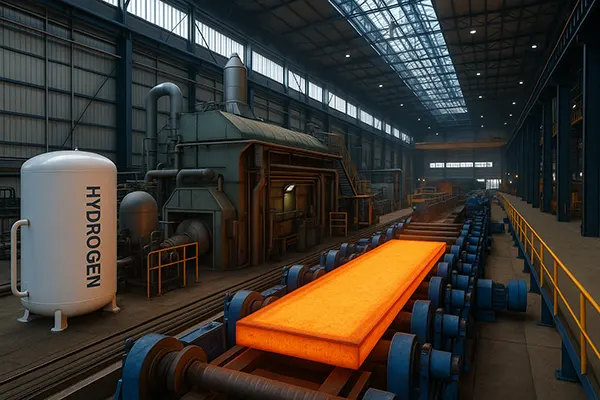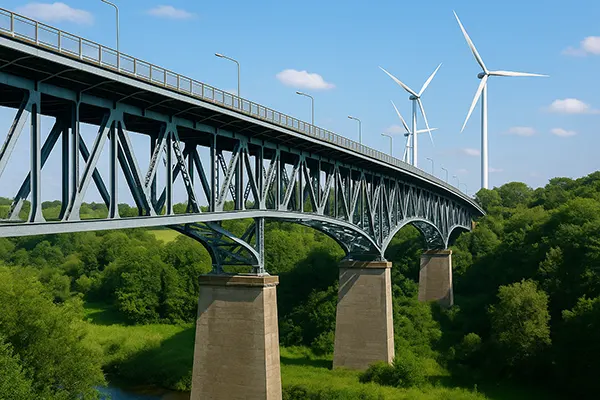Green Steel: How Carbon-Free Steel Is Reshaping Global Industry in 2025

In 2025, the steel industry is undergoing a profound transformation, driven by an urgent global need to decarbonise heavy manufacturing. At the heart of this evolution is “green steel”—a revolutionary material produced without using coal or emitting carbon dioxide. With governments tightening emissions regulations and consumers demanding more sustainable products, green steel is no longer a futuristic concept but a present-day industrial necessity. This shift promises to reshape sectors ranging from construction to automotive, paving the way for a more climate-resilient global economy.
The Rise of Green Steel Production
Green steel is produced using hydrogen-based direct reduced iron (DRI) processes or electric arc furnaces (EAF) powered by renewable energy. Unlike traditional blast furnaces that emit vast quantities of CO₂, these methods eliminate coal entirely from the equation. As of February 2025, Sweden’s H2 Green Steel and Germany’s Salzgitter AG are among the leading innovators, having launched full-scale commercial production lines. These companies have achieved significant reductions in lifecycle emissions and set benchmarks for industrial decarbonisation worldwide.
One of the main drivers behind the adoption of green steel is regulatory pressure. The European Union’s Carbon Border Adjustment Mechanism (CBAM), which expands in 2026, incentivises industries to embrace low-carbon alternatives. Major steel-consuming corporations like Volvo, BMW, and IKEA have entered procurement agreements for green steel to meet their ESG commitments and mitigate future carbon taxes.
Technological improvements and declining hydrogen production costs are accelerating the commercial viability of green steel. Electrolysis-based hydrogen, when powered by wind or solar energy, provides a nearly zero-emission solution. Industrial clusters in Northern Europe are rapidly investing in electrolyser capacity and green energy infrastructure to scale operations.
Challenges in Scaling the Technology
Despite progress, scaling green steel production to global levels remains a formidable challenge. High capital investment, limited green hydrogen availability, and the need to overhaul existing infrastructure continue to slow widespread adoption. Many countries lack sufficient renewable energy supply to meet the high power demands of hydrogen-based steelmaking.
Furthermore, most steel plants across Asia, which dominate global output, still rely heavily on coal-based methods. Transitioning these facilities requires extensive financing, cross-border collaboration, and policy alignment. Efforts like the Global Green Steel Compact aim to facilitate knowledge sharing and support industrial decarbonisation in developing economies.
Supply chain resilience also poses a concern. Green hydrogen storage and transport infrastructure is underdeveloped, and fluctuations in renewable energy supply can affect production stability. Nevertheless, industry leaders believe that with clear policy signals and increased investment, these hurdles can be overcome within the next decade.
Market Demand and Economic Impacts
Global demand for green steel is surging in 2025. Automotive, construction, and renewable energy sectors are rapidly integrating low-carbon materials into their supply chains. According to data from BloombergNEF, the green steel market is projected to grow by 37% annually through 2030, with demand outstripping supply in the short term.
Leading automakers like Mercedes-Benz and Polestar have pledged to use green steel in their production lines, reinforcing the material’s importance in achieving net-zero targets. Similarly, major real estate developers in Europe and Australia are incorporating it into sustainable building projects to meet stricter environmental certifications.
Economically, green steel is still more expensive than conventional steel—by approximately 20–30% per tonne. However, this green premium is expected to shrink as economies of scale and renewable energy prices continue to improve. In the long term, companies that fail to transition may face carbon penalties, reputational damage, and loss of market share.
Investment and Policy Momentum
Government incentives and public-private partnerships are critical in driving the green steel transition. In 2025, the European Investment Bank, along with national governments, is financing several major hydrogen-steel projects, offering tax incentives and subsidies to early adopters. The US Department of Energy has also pledged over $1 billion towards clean industrial technologies, including steel decarbonisation.
Carbon pricing mechanisms are further tipping the scales in favour of low-emission production. The global average carbon price has climbed above $90 per tonne in early 2025, making fossil-fuel-intensive methods financially less viable. Countries that integrate carbon costs into industrial planning are better positioned to attract green investment.
Private capital is also pouring into green steel. Venture capital firms and green investment funds see long-term potential in climate-resilient materials. As ESG ratings increasingly influence investment decisions, green steel producers are experiencing a surge in valuations and project funding.

Outlook for Global Steel Transition
The outlook for green steel in 2025 is more optimistic than ever. While challenges persist, international cooperation and market dynamics are aligning to accelerate the shift. Leading economies are embedding green steel into their climate strategies, and emerging nations are receiving support to avoid locking in high-emission infrastructure.
Technological advancements are expected to further reduce production costs and energy use. Innovations in hydrogen storage, smart grid integration, and AI-driven process optimisation are being explored to enhance efficiency. With more nations committing to net-zero goals, policy coherence across borders is improving, supporting global adoption.
Ultimately, green steel represents a cornerstone of sustainable industry. It offers not just a path to lower emissions, but also industrial revitalisation and energy independence. As awareness spreads and costs fall, green steel is on track to become the new norm in heavy industry, reshaping not only how we build but how we balance economic growth with environmental responsibility.
Role of Industry Collaboration and Innovation
Collaboration between governments, research institutions, and private firms is crucial in accelerating innovation. Joint ventures such as Hybrit in Sweden demonstrate how public and private stakeholders can pool resources to fast-track commercial breakthroughs. These partnerships are setting blueprints for similar initiatives worldwide.
Innovation is not limited to production methods. Digital monitoring systems, blockchain-based certification of green steel, and AI-enhanced supply chain management are also transforming the industry. These tools enable transparency, traceability, and accountability across the value chain, increasing trust among stakeholders.
Education and workforce development are also gaining focus. As the sector shifts, demand for new skill sets in green hydrogen, renewable energy, and advanced metallurgy is growing. Vocational training and university programmes are being redesigned to align with the requirements of a green industrial future.
